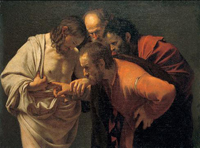 Germany Thanks Russia for Returned Art, Asks for the Rest Back
Germany Thanks Russia for Returned Art, Asks for the Rest Back Review by Catherine Hickley
Aug. 18 (Bloomberg) -- Fifty years ago, the Soviet Union returned 1.5 million art treasures looted at the end of World War II to East Germany. Twenty-eight German museums are staging a series of exhibitions to say thank you.
Gratitude is one half of the message. The other is: Can we have the remaining 1 million works back now too, please?
Ever since reunification in 1990, Germany has been gently pressuring Russia for the return of the art, with few results. Many Russians, including museum directors, view the booty as legitimate compensation for Soviet treasures looted or destroyed by Hitler's troops. Under Russian law, German art taken by Stalin's Soviet Trophy Commission is Russian state property.
It's safe to assume that with conflict in Georgia to watch, the Russian authorities are paying scant attention to the first of the nine planned shows. Yet ``Fifty Years of Loss and Return'' at Sanssouci, the summer palace commissioned by Frederick the Great in Potsdam, offers an interesting insight into the scale of the losses -- and the scope of that restitution in 1958.
In an act of friendship to communist East Germany, 300 train carriages from Moscow and St. Petersburg carried back 1.5 million of the 2.5 million art treasures that disappeared at the end of the war. Without that gesture, the Pergamon Museum in Berlin would be bereft of the Pergamon Altar and postcards and mouse mats in Dresden's tourist shops would have to feature something other than the cherubs of Raphael's ``Sistine Madonna.''
Like Christmas Unpacking the crates must have been like a lifetime of Christmases and birthdays rolled into one for the East German museums, many of which celebrated the return of their errant treasures with grand reopenings. Yet the hangover lingers to this day: Almost half of the art never came back.
German museum directors still don't know what the criteria were in selecting what should be shipped home and what should stay in Russia. It may be that much of the rest was looted by individuals before the arrival of the Trophy Commission, Hermann Parzinger, the president of the Prussian Culture Foundation, said at the opening of the Sanssouci show.
``We think much has ended up in private hands,'' Parzinger said. He said he doesn't expect the current series of exhibitions to produce instant results in recovering the art. His main priority is to deepen a dialogue with Russian museums so that curators can get a clearer idea of ``what has gone missing, what is where, and what kind of a state it is in,'' he said.
The Foundation for Prussian Palaces and Gardens, which manages Sanssouci and other similar sites, is still missing about 3,000 works. Of the 159 paintings that hung in Frederick's ornate, gilded picture gallery before the war, 99 are lost.
Rembrandt, Rubens Curators filled the gaps with paintings returned by the Soviet Union that were looted from other palaces, some of which were destroyed in the war. The paintings, including works by Rubens, Van Dyck, Rembrandt, Caravaggio, Ferdinand Bol, Guido Reni and Jan Lievens, hang in the baroque style -- close together, almost completely obscuring the wall on one side of Frederick's gallery built between 1755 and 1763.
The exhibition includes illustrations of how the gallery looked before the war, with black-and-white photographs of the missing pictures. It's clear that it no longer fully represents Frederick's collecting habits: many of the lost works have been replaced with paintings of religious subjects, while Frederick preferred mythological figures.
He also had a taste for voluptuous nudes and love scenes that whoever plundered his collection in 1945 must have shared. Gone are his Danaes and Venuses and Giulio Romano's renaissance erotica: A young couple depicted kissing naked on a bed as an elderly woman, possibly a nurse, looks on.
Stashed Rubens One gaping loss is a Rubens masterpiece, ``Tarquinius and Lucretia,'' that was cut out of its frame by a Soviet officer before the arrival of Stalin's Trophy Commission. He kept it rolled up and stored in his attic until his death in 1999.
A private collector then purchased it in Moscow for $3.5 million and paid for a costly renovation before trying to sell it back to Germany for $60 million. The German government turned down the offer and sued to try to recover the picture. A Moscow court rejected the claim, saying the current owner had acquired it ``in good faith.''
Other cases of private looting have ended more felicitously. One war veteran was weighed down by guilt and handed 101 works on paper over to the German embassy in Moscow in 1993.
The graphics and drawings by Duerer, Manet, Toulouse- Lautrec and Goya had been stored for safekeeping during the war in Karnzow Palace in the eastern region of Brandenburg. They were returned to the Bremen art museum in 2000.
``Fifty Years of Loss and Return'' is at Sanssouci, Potsdam, through Oct. 31. Similar events are taking place in Aachen, Berlin, Bremen, Dessau, Dresden, Gotha and Schwerin.
For information on the Russian-German museum dialogue, go to http://www.kulturstiftung.de/f_set01.htm. For information on the current exhibition at Sanssouci and the Foundation for Prussian Palaces and Gardens, see http://www.spsg.de/index_2326_de.html.
To contact the writer on this story: Catherine Hickley in Berlin at chickley@bloomberg.net.
Last Updated: August 17, 2008 19:55 EDT
 Germany Thanks Russia for Returned Art, Asks for the Rest Back
Germany Thanks Russia for Returned Art, Asks for the Rest Back